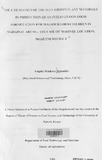| dc.description.abstract | Child malnutrition is a major health problem in developing countries. Protein energy
malnutrition, vitamin A deficiency and iron deficiency anaemia are the major nutrition
problems that occur in pre-school children. In Kenya, 36% of the under fives are
malnourished. This problem is more prevalent in the marginal areas, which constitute
80% of the country. Various long-term interventions have been formulated to address
malnutrition. This project offered a food-based approach to combat child malnutrition
and aimed at contributing towards immediate nutritional intervention through a
participatory approach. It links technology to community development.
A study site was selected in one of the marginal areas of Kenya and the study carried
out in two phases. The study site selected was Makindu Location in Makueni District,
Eastern province. The first was a situation analysis of the area, which doubled up as a
feasibility study for the suitability of the project. The second involved development of
an intervention product. In the situation analysis, data on socio-economic status,
nutritional status and crops grown locally in the area were collected via cross sectional
survey using household and key informant questionnaires.
The results showed that the mean household size (5.2) is similar to the country's mean
and that 33% of the population is below 5 years. Poverty is rampant in the area, 58%
live below the poverty line. The major crops grown are pigeon pea, maize and cowpeas. Unfortunately there exist food taboos linked to use of dry pigeon pea. The nutritional
status of the children was not significantly different (p>0.05) from the country's. The
prevalence of chronic malnutrition was 37.5% while that of stunting was 7%. Based on
computation of energy and nutrient content, the household diets were deficient in their
supply of vitamin A, energy and protein. Over 80% of the households did not meet their
vitamin A requirements, about 40% did not meet their energy requirements and 20% did
not meet their protein requirements. Household diets were most deficient in vitamin A
supply.
In order to meet the community's nutritional needs and based on the results obtained, a
food ration, later named 'Makindu Sweet Flour' by the community, was produced using
locally grown raw materials that is maize, pigeon pea and orange fleshed sweetpotato.
This formulation was developed through the three phases of product development:
product design, product adjustment and product evaluation. The major ingredients were
selected from a database containing the composition of all food crops grown in the area
using linear programming. Makindu Sweet flour is roasted sweetened flour that
provides more than 50 % of the RDA (for a 2 to 3 year old) in terms of energy, protein
and vitamin A in 450 ml of the final product. This project linked technology to
community needs, leading to sustainable community health through nutrition. | en |

